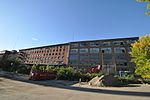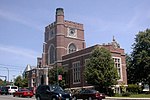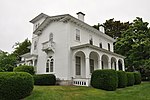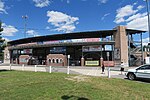St. Stanislaus Parish, Nashua
Buildings and structures in Nashua, New HampshireChurches in Hillsborough County, New HampshireChurches in the Roman Catholic Diocese of ManchesterChurches used by the Priestly Fraternity of St. PeterPolish-American Roman Catholic parishes in New England ... and 1 more
Roman Catholic parishes and churches in New Hampshire

St. Stanislaus Parish is a Catholic parish of the Diocese of Manchester, located in Nashua, New Hampshire, United States. The first parish at the site was established in 1908 for Polish immigrants by Bishop George Albert Guertin. The current parish was founded in 2016 by Bishop Peter Anthony Libasci and dedicated to observing the Tridentine Mass and other liturgical rites in use prior to Vatican II.
Excerpt from the Wikipedia article St. Stanislaus Parish, Nashua (License: CC BY-SA 3.0, Authors, Images).St. Stanislaus Parish, Nashua
Franklin Street, Nashua
Geographical coordinates (GPS) Address Website Nearby Places Show on map
Geographical coordinates (GPS)
| Latitude | Longitude |
|---|---|
| N 42.7635 ° | E -71.46925 ° |
Address
Chorpus Christi Chapel & Food Pantry
Franklin Street 43
03064 Nashua (Ward 3)
New Hampshire, United States
Open on Google Maps











